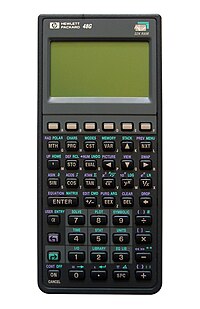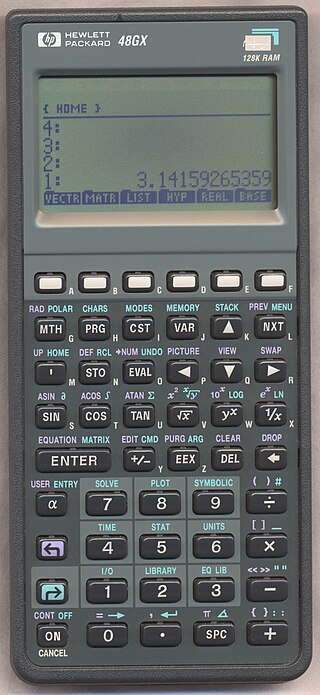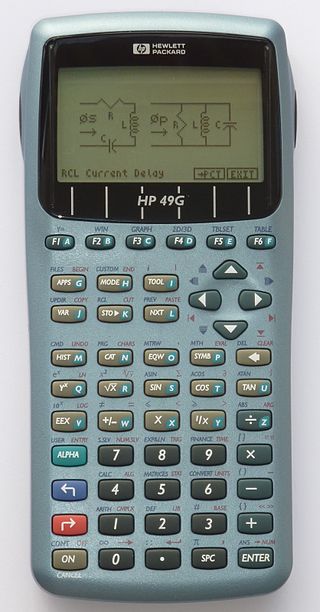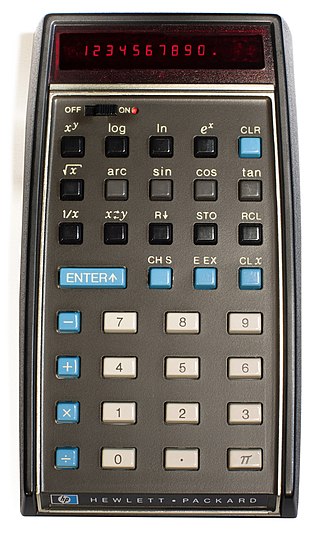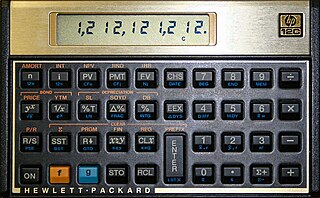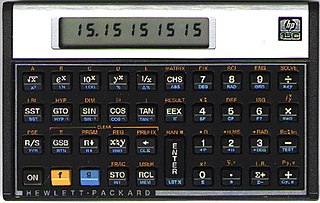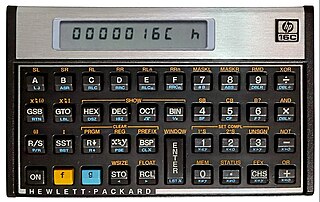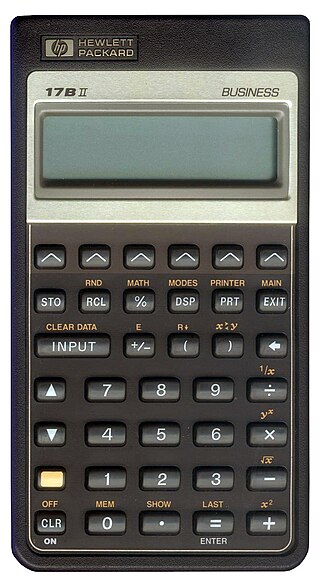| Product | Year | Description |
|---|
| HP 9g | 2003 | Graphing calculator designed by Kinpo Electronics, Inc. [3] |
| HP 9s | 2002 | Scientific calculator designed by Kinpo Electronics, Inc., with the same form factor as the 9g and the 30S |
| HP-10 | 1977 | Basic four-function calculator with printer and conventional arithmetic entry (no RPN). |
| HP-10B | 1987 | Financial calculator |
| HP-10C | 1982 | Range entry calculator, Scientific Programmable, statistical functions. |
| HP-10S+ | 2012 | A dual-powered (battery and solar cells) algebraic scientific calculator with 2-line dot matrix and segment display. |
| HP-11C | 1981 | Scientific Programmable, including hyperbolics, gamma function, statistical functions, and random number generation. |
| HP-10s | 2007 | A scientific calculator with more than 240 built-in functions, with 2 lines × 10 digits LCD. |
| HP-12C | 1981 | The finance-centric programmable calculator from the Voyager series introduced in the 1980s. The longest running product in the HP calculator line, it remains in production. Various models exist, the latest in 2008. |
| HP-14B | 1988 | Finance calculator with 12 digits precision and algebraic logic. It has 130 functions, 41 keys, and an LCD display. [4] |
| HP-15C | 1982 | Advanced Scientific Programmable, including hyperbolics, gamma function, combinatorial and statistical functions, random number generation, numerical integration, numerical root finding, plus comprehensive matrix operations and full support for complex numbers. |
| HP-16C | 1982 | Computer science programmable calculator that could perform binary arithmetic, base-conversion (decimal, and binary, octal, and hexadecimal) and boolean-logic functions. |
| HP-17B | 1988 | Financial calculator superseding the 12C, with two-line display, alphanumerics and sophisticated Solve functions rather than step programming. Uses the Saturn chip set. |
| HP-18C | 1986 | RPL clamshell business calculator. |
| HP-19B | 1988 | Financial calculator. |
| HP-19C | 1977 | Calculator with RPN and built-in thermal printer. Included a programming language with looping and branching. |
| HP 20b | 2008 | Financial calculator with RPN. |
| HP-20S | 1988 | A basic scientific calculator, using infix notation, barely programmable and with no graphing capabilities. |
| HP-21 | 1975 | Scaled-down HP-25. |
| HP-21S | 1989 | An algebraic, keystroke programming calculator. |
| HP-22S | 1988 | An algebraic scientific/statistics calculator. |
| HP-25 | 1975 | Smaller programmable model with programs up to 49 steps. Version HP-25C was first calculator with "continuous memory". |
| HP-27S | 1988 | The first HP pocket calculator to use algebraic notation only rather than RPN. It was a "do all" calculator that included algebraic solver like the HP-18C, statistical, probability and time/value of money calculations. It had approximately 7 kilobytes of programmable memory which could be used for formulas or notes. The two-push 6-key letter typing system was fairly fast after a learning period. [5] |
| HP-28C | 1987 | RPN scientific graphing calculator. First HP graphing calculator, and introduced the Forth-like RPL, programmable keys, and symbolic equation solving, with 2 KB of user memory. Book-style design (flip-open cover) with keys on both interior halves. |
| HP-28S | 1988 | Expansion of HP-28C; 32 KB of user memory due to customers unexpectedly keeping programs in memory for extended periods. Introduced a file system for storing variables, functions, and user programs in the form of a multi-level tree. Like the HP-28C, this model used the "open-book" physical design. Functionally a direct predecessor to the HP-48 series, which returned to a more traditional physical design based on the HP-41. |
| HP-29C | 1977 | Programmable calculator with RPN. Included a programming language with looping and branching. An inexpensive variation on the 19C printer. |
| HP 30b | 2010 | Programmable Financial calculator released in 2010. Built in Black-Scholes Equation, FMRR and MIRR. Powered by ARM processor. Multiple input methods including RPN, chain algebraic, and normal. |
| HP 30s | 2000 | Calculator designed by Kinpo Electronics, Inc. |
| HP-32E | 1978 | Scientific non-programmable |
| HP-32S | 1988 | Scientific programmable, updated to HP-32SII |
| HP 33s | 2003 | Calculator designed by Kinpo Electronics, Inc. Successor to the HP-32SII. |
| HP-33C | 1978 | Scientific Programmable—successor to the HP-25 and HP-25C. |
| HP-34C | 1979 | Scientific Programmable calculator. First with integration and Root Finding. |
| HP-35 | 1972 | HP's first pocket calculator, and the world's first pocket calculator with transcendental functions. As such, it is regarded as the first "scientific" calculator. |
| HP 35s | 2007 | Introduced to commemorate the 35th anniversary of the HP-35, it is an advanced scientific programmable calculator, featuring algebraic and RPN modes, hyperbolics, statistics, numerical integration, numerical solver, random number generation, equations, and full programmability, using up to 32 Kb of RAM for programs and data. |
| HP 38G | 1995 | A simplified graphic model, using infix notation. |
| HP 39G | 2000 | A successor to the HP-38, using infix notation. |
| HP 39gs | 2006 | A successor to the HP 38G. It does not support RPN. |
| HP 39gII | 2011 | A successor to the HP 39gs. Nearly identical in features but with a high-resolution screen and internationalized for the Chinese market. |
| HP 40G series | 2000 | A successor to the HP 38G, using infix notation. The 40G is identical to the 39G but adds a computer algebra system. |
| HP-41 series | 1979 | Three models in this series were released over its lifetime, the 41C, 41CV, and 41CX. The 41C had user configurable program steps and memory registers, alpha-numeric display, user programmable key mappings, and four expansion ports that could hold additional memory, an interface to HP-IL peripherals, a magnetic card reader–writer, or commercial application programs. The 41CV quintupled the amount of base memory, and the 41CX added a clock and some additional functions and memory. |
| HP-42S | 1988 | A non-expandable follow-up to the HP-41 series. It included a two line display (dot addressable) and featured built-in matrix and complex number mathematics. |
| HP-45 | 1973 | Improved version of the HP-35 with 10 memory registers, extra functions and display format selection. |
| HP 48 series | 1990 | Programmable graphic calculators, initially the SX and a year later the cheaper S, and three years later the G and GX with a faster processor and more graphical interface; SX and GX versions had expansion slots. Based on the functionality of the HP-28S, but with a return to a traditional appearance (similar to the HP-41 series). Historically one of the most popular models among engineers. Uses a filesystem first introduced on the HP-28S. Has a real-time clock and an operating system with programmable-action alarms, which could turn on the calculator and run arbitrary user programs at a user-specified time & frequency. |
| HP 49/50 series | 1999 | Enhanced, graphic versions of the HP 48 series. Later models designed by Kinpo Electronics, Inc. |
| HP 50g | 2006 | The latest member of the HP 49 series. Faster (ARM processor), larger display, and ability to read/write removable SD memory cards. |
| HP-55 | 1975 | Lower cost version of the HP-65; no magnetic card reader, only 49 programming steps, but had 20 registers instead of just nine. Only model with an accurate (quartz crystal) stopwatch mode. |
| HP-65 | 1974 | First programmable pocket calculator. Programs could be up to 100 steps in length and could be written to or read from magnetic strips. |
| HP-67 | 1976 | Improved version of the HP-65. |
| HP-71B | 1984 | Handheld model natively programmable in an extended BASIC language including a RAM-based filesystem, recursion, multiline user-defined functions and subprogram calling with parameter passing, but also capable of accepting plug-in ROM modules to provide such functionalities as full I/O capabilities to any type of device (printers, mass storage, measurement instruments), programmability in other languages (Forth, Assembler), advanced math capabilities (such as matrix operations, support for complex numbers, multidimensional numerical integration and root finding, Fast Fourier Transforms, etc.), and an advanced Calculator Mode capable of executing algebraic expressions one step at a time and undoing individual steps. |
| HP-80 | 1973 | HP's second handheld calculator, designed for business and including functions for Time Value Of Money , Sum of Digits depreciation and similar. [6] |
| HP-97 | 1977 | Desktop and printing version of the HP-67. |
| HP-300S+ | 2012 | A dual-powered (battery and solar cells) algebraic scientific calculator with 4-lines LCD screen and can display expressions in textbook format. |
| HP Prime | 2013 | A "smartphone competitor" with a 3+1⁄2-inch color touch screen, "apps", CAS and exam feature that allows both selection of RPN vs. Algebraic vs. textbook and exam format for use on the SAT. Includes several new features such as color graphing animation and wireless (dongle) connectivity. |
